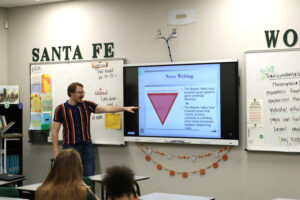Bringing the Real World into the Classroom
Edmond teacher asks local journalists to help students.
By Monica Royer, OEA Communications Staff

In recent years, there has been a push for more integration and partnership of community resources and career professionals in the classroom, especially at the secondary level. Educators, parents, and community members recognize the importance of students being able to see themselves in the workforce and help them to pursue their dream careers. Callie Reichert, an English III teacher and Newspaper Advisor, knew that regardless of her passion for English and experience as a student journalist, her newspaper students needed more. They needed to learn from someone in the trade, but more importantly, to be inspired by them, so she invited local reporters to come to her classroom.
“I am new to helping with our student newspaper this year, and it occurred to me it would be beneficial for both me and my students to hear from real professionals,” Reichert explained.
With the help of OEA, Reichert was able to get connected with journalists Nuria Martinez-Keel from Oklahoma Voice and Blake Douglas from NonDoc. Martinez-Keel, a long-time education journalist, jumped at the opportunity immediately.
“As an education reporter, I enjoy visiting schools and interacting with the teachers and students who are at the heart of the beat I cover,” Keel said.
Although Keel is an established writer, she recognized the importance of going back to her roots and lifting up the next generation of journalists.
“Every professional journalist started somewhere,” Keel explained. “Those of us farther down the road should share what we know with those at the beginning of their journey, and the students I visited are much farther along than I was at their age.”
Douglas, who leads NonDoc’s Edmond Civic Reporting Project, felt especially connected to students in this area.

“Everywhere across the country, but especially in Edmond as a town that is now without its traditional newspaper or record, it’s important for journalism students to have access to working journalists,” Douglas explained. “It’s even more important they can hear from those that actually cover the communities they live and study in, given that is where they’ll be laying the foundation for their understanding of journalism.”
During both visits, Reichert was thrilled to see her students entranced by the reporters and eager to learn. Upon hearing that the visits were scheduled, they prepared questions and sought help with interviews and overall writing structure. Keel and Douglas presented tips and tricks for the students.
“I shared with them the method I learned in college to structure a news article,” Keel explained. “The method is called the High Five, and it helps the writer prioritize what pertinent information should go at the top of a story.”
Although the writing tips helped, it was the personal narratives that really drew the students in.
“Real-world experience trumps traditional lecture every time—it’s just much more engaging,” Reichert said. “Journalists come in with real stories and details about things they have dealt with in the field and those are things I would never be able to include in a traditional curriculum since I do not have those experiences.”
Keel and Douglas did not take this responsibility lightly. Keel knew that she could do more than just try to get kids to be journalists—she could help them with life skills.
“Even if none of these students ultimately pursue a journalism career, I think it’s important to learn what goes into a quality news story and how a proper interview is conducted,” Keel said. “Media literacy is a skill that will help them throughout life.”
Douglas wanted to be sure that if any students were serious about pursuing this career, they would know what to expect.
“With general trust of legacy media outlets at one of the lowest points it’s ever been, working journalists have a responsibility to explain to prospective writers the circumstances that have caused that slip, some within the control of media and some without,” Douglas explained. “The only way to recover that lost trust is through ethical, contextual and skillful reporting, something that the next generation of news media has to be ready to prioritize.”
After both visits, all parties involved were grateful for the experience. Reichert immediately saw a spark lit in her students and was eager to ask the reporters for more visits.
“These visits meant a lot to me because these professionals gave up their own time to be there and answer questions,” Reichert said.
Douglas was also moved by the experience because he did not have the opportunities that these kids do.
“As someone whose high school did not have a paper, I’m glad to see not just that the program exists here but has attracted a lot of curious students to take part!” Douglas exclaimed.
This experience shows that education should not be limited to the walls of a school. When members of the community come into the classroom and work with teachers, magic can happen. Students need opportunities to know what possibilities are out in the world and sometimes even when a teacher tells them, it is hard to believe. But when community members come in and make a connection, it can make a world of difference in perspective.
This story was a part of the 2025 Spring edition of OEA’s Education Focus magazine.
